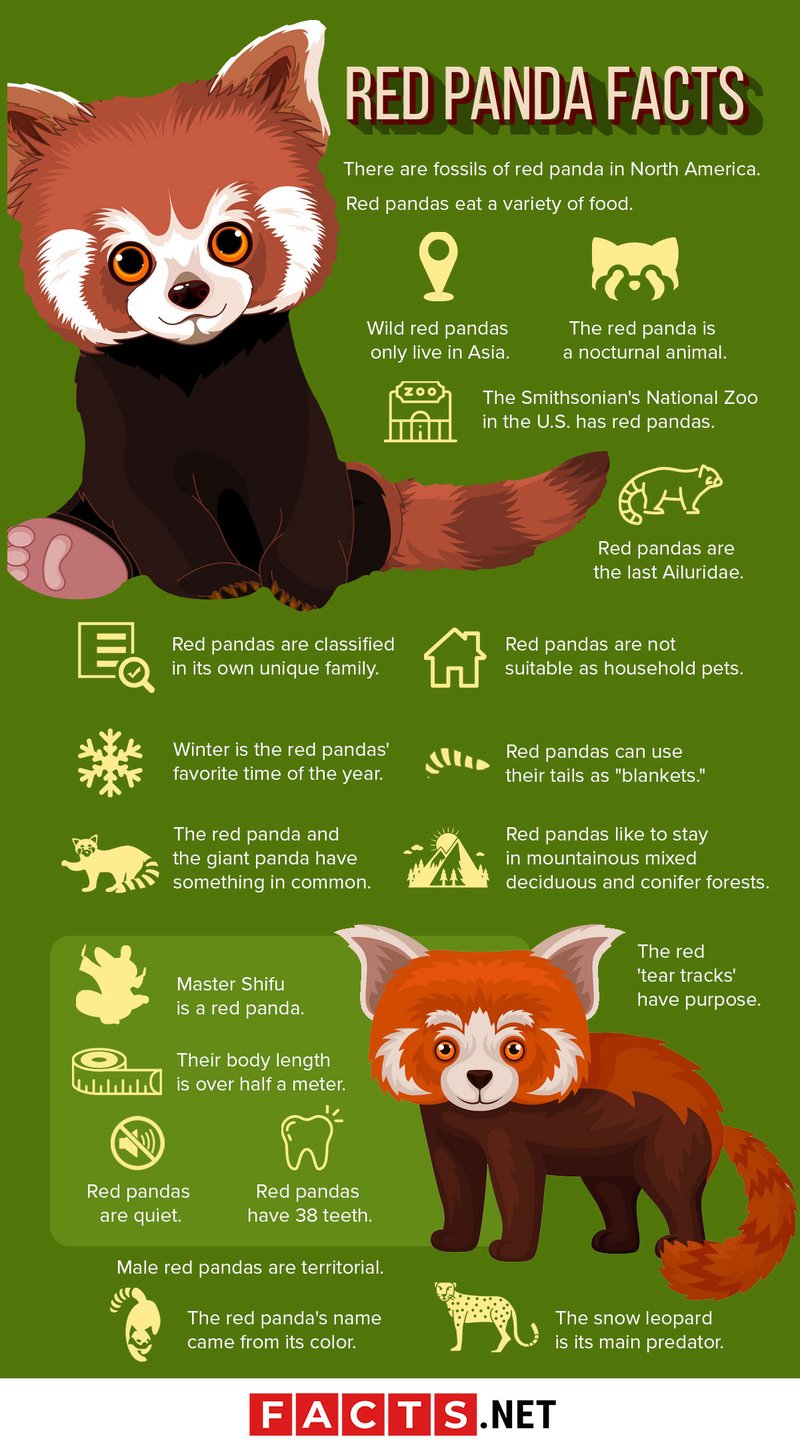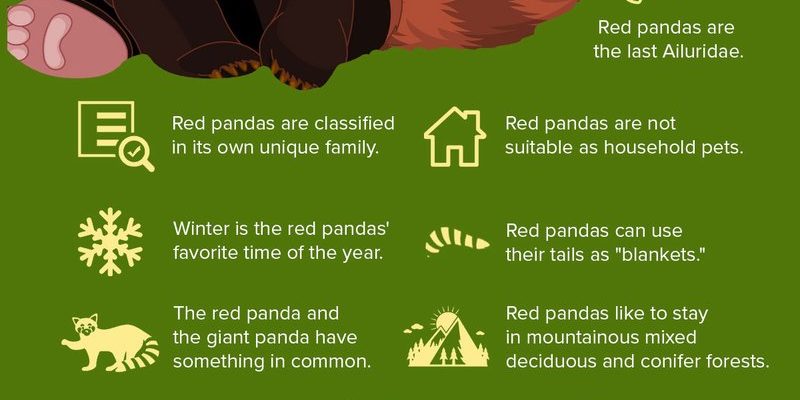
While red pandas may be small, they pack a whole lot of charm into their furry bodies. They live mainly in the cool, mountainous forests of China, Nepal, and India, where they blend in with their surroundings. Unlike giant pandas, which are known for their bamboo diets, red pandas have a more varied menu, choosing from fruits, berries, and even some flowers. So, if you’re imagining their diet, think of a trendy café that serves both exotic salads and sweet treats—it’s a mix of flavors!
Now, let’s take a closer look at these incredible animals through ten fascinating facts that will make you appreciate red pandas even more.
1. Red Pandas Are Not Actually Pandas
You might be surprised to learn that red pandas are not closely related to the giant pandas we all know and love. In fact, they belong to their own unique family called Ailuridae. Here’s the kicker: red pandas are more closely related to raccoons and skunks than they are to giant pandas! It’s like discovering your friend’s long-lost twin who has a slightly different style.
Why the name, then? Well, the name “panda” is derived from the Nepali word “nigalya ponya,” meaning “bamboo eater.” It references the red panda’s diet, which includes bamboo, just like its black-and-white counterpart. So, while they share a love for bamboo, their family trees tell a different story.
2. Unique Physical Features
Red pandas are truly one-of-a-kind! They have distinctive features that make them stand out. For starters, their fur is a striking rust color with hints of black on their legs and a creamy white face. This beautiful coat serves a practical purpose—it helps them blend into their forest habitats, making it easier to hide from predators.
Have you ever noticed how their paws look? They have specialized, disc-like pads on their feet that help them climb trees with ease. Think of it like wearing fuzzy slippers that grip onto the bark! Plus, their long, bushy tails help them balance as they navigate the treetops, almost like a tightrope walker. These traits not only make red pandas adorable but also incredibly well-adapted to their environment.
3. They’re Masters of Climbing
If you enjoy watching animals climb and play, red pandas will not disappoint! These little acrobats spend most of their time in trees, where they feel safe from threats. Their strong limbs and sharp claws allow them to be excellent climbers. You might even catch them hanging upside down from a branch, just like a playful child on a jungle gym!
Red pandas have a special way of climbing, too; they often descend trees headfirst! This kind of maneuver is pretty uncommon in the animal kingdom, and it shows how agile and flexible these creatures are. Just imagine how fun it would be to zip up and down the tree trunks with such ease!
4. Mostly Solitary Creatures
When you think about social animals, red pandas might not come to mind. They tend to be solitary and spend much of their time alone, especially the males. Picture a quirky introvert who loves their own company—red pandas are like that! However, during mating season, they do come together to find a partner.
Interestingly, they mark their territory with scent glands, letting others know where they’ve been. It’s a bit like leaving a note on a friend’s door saying, “Hey, I was here!” This behavior helps maintain distance from one another and keeps conflicts at bay in their lush forest homes.
5. Diet Differences
You might think that red pandas only eat bamboo, but their diet is a bit more diverse. While bamboo is a big part of their meals—making up about 95% of their diet—they also enjoy fruits, nuts, and even some insects. It’s like being on a diet that’s all about finding a healthy balance between salads and sweet treats!
Unlike giant pandas, red pandas are not limited to just one food source; they have evolved to be quite flexible eaters. This diet variety helps them thrive in the wild, especially as bamboo can be scarce in certain seasons. So, if you picture a delightful buffet with different options, that’s how red pandas approach their meals!
6. Communication Through Sounds
Communication is key in any friendship, isn’t it? Red pandas have a unique way of talking to each other, using a variety of sounds to express themselves. They can make a range of noises, from squeals and chirps to whistles and even grunts. Think of it as their own little language that helps them convey how they’re feeling.
Each sound serves a different purpose. For instance, a low grunt might signal distress, while higher-pitched squeals can indicate excitement or playfulness. So, if you ever hear a red panda making noise, it’s like they’re having their own little conversation, complete with emotions and enthusiasm.
7. They’re Mostly Nocturnal
If you’re an early riser, you might not catch a glimpse of a red panda during the day. These creatures are predominantly nocturnal, meaning they’re more active at night. Picture them as the night owls of the animal world, exploring their territory while most of the world sleeps. Their big, round eyes are perfectly designed for low-light conditions, allowing them to navigate through the dark forest with ease.
This nighttime activity gives them an advantage when it comes to finding food and avoiding predators. As they skip through the branches under the moonlight, they turn their nightly adventures into a delightful dance that many of us would love to join!
8. Conservation Status and Threats
Red pandas face challenges that put them at risk. They are currently listed as endangered, primarily due to habitat loss, poaching, and climate change. As forests are cleared for agriculture and urban development, red pandas lose their homes. It’s like taking away their cozy living room and asking them to find a new one without any guidance.
Conservation efforts are crucial for protecting red pandas and their habitats. Organizations work tirelessly to create protected areas and educate local communities about the importance of these charming creatures. If you’re passionate about wildlife, supporting these initiatives can make a huge difference for red pandas in the wild.
9. Unique Reproduction
When it comes to love, red pandas have their own unique ways. The mating season usually occurs between January and March, and female red pandas go into heat for just a couple of days. After mating, the female may give birth to one to four cubs, usually in June or July. It’s like a surprise party where the guests of honor are tiny, fuzzy babies!
The cubs are born blind and depend entirely on their mother for warmth and food. As they grow, they start to open their eyes and explore the world. Watching these little ones play and learn is one of nature’s most heartwarming experiences.
10. Cultural Significance
Red pandas are more than just cute faces; they hold a special place in the cultures of the regions where they live. In some places, they are considered symbols of good luck and are celebrated in local folklore. Their playful and gentle nature has won the hearts of many, making them popular in zoos and wildlife parks worldwide.
A fun fact: they are often called “fire foxes” in some Asian cultures due to their reddish fur and bushy tails. This name links them to the mythical creatures that are seen as protectors against misfortune. So, in a way, these adorable animals carry the weight of cultural significance, connecting them to the communities that cherish them.
In conclusion, red pandas are truly fascinating creatures that deserve our admiration and protection. From their unique family ties to their charming personalities, there’s so much to love about them. Next time you’re enjoying a stroll in nature or visiting a zoo, take a moment to appreciate these incredible animals. They might just inspire you to look deeper into the world around us and our role in preserving it.

